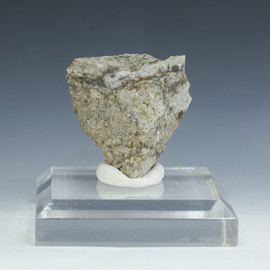Nuvvuagittuq "Microfossils" Hydrothermal Vent
Brand : Jensan Scientifics LLC
- SKU:
- JPT-89426
- Condition:
- New
- Availability:
- Usually ships in 24 hours.
- Weight:
- 1.00 LBS
- Minimum Purchase:
- 1 unit
- Maximum Purchase:
- 1 unit
- Gift wrapping:
- Options available
- Shipping:
- Calculated at Checkout
This scientific specimen is from the Nuvvuagittuq "Microfossils" microbial life ancient hydrothermal vent location in Canada. Many consider it to be the earliest fossil evidence of life on Earth. The earliest fossil record of life trails back into the vaste depths of "Earth time." Before there were dinosaurs and the oldest stromatolites, there were microfossils and cells that built stromatolites.
Scientists analyzed jasper rock samples. They discovered microfossils - tiny remains of ancient organisms. These "microfossils" appeared to have filament-like structures and tubes filled with hematite. They bore resemblance to microbes found living in current-day hydrothermal vent systems.
1. The Nuvvuagittuq Supracrustal Belt (NSB)
- The NSB in Canada is a geological formation that once belonged to an early oceanic crust.
- It contains ancient rocks that have preserved clues about Earth's early past and what may be the earliest fossil evidence of life on Earth.
2. Microfossils and Rosettes: Evidence of Ancient Life
- Scientists studied thin sections of fragments from the NSB using optical microscopy.
- They identified rosette-like structures measuring 50–200 μm.
- Chemical imaging with a Raman microscope revealed the compounds present to be: calcite, hematite, quartz, magnetite, and apatite.
- These structures resembled hematite tubes (interpreted as microfossils).
3. Iron-Metabolizing Filamentous Bacteria
- Modern iron-oxidizing bacteria living in hot vents can form Fe-containing filaments and tubes.
- The ancient rosettes and tubes in the NSB rocks are believed to be remnants of similar iron-metabolizing bacteria found in vent systems.
- These filamentous bacteria may represent some of the oldest life forms recognized on Earth.
4. Implications for Life's Origins
- The evidence suggests that life established a habitat near submarine-hydrothermal vents ~3700 million years ago (Myr) and may even have emerged as early as 4,290 Myr ago.
- Ancient submarine-hydrothermal vent systems are now considered potential sites for life's origins on Earth and are crucial targets in the search for extraterrestrial life, in astrobiology.
Conclusion: These ancient rocks from the NSB provide valuable insights into the early history of life on our planet and the hydrothermal jaspilite “microfossil locality” may offer definitive evidence for the emergence of life on our planet ~ 4.2 Ga. Some scientists think that the earliest cells developed in volcanically active hydrothermal environments.
Size of Specimen: 45mm L X 60mm W X 5mm D, Weight: 25.9 grams
This specimen ships with a Certificate of Authenticity, tag, tag stand and information about the specimen. The macro photo is 40X from this exact specimen. This specimen was legally obtained and is a very rare specimen. It was lightly sprayed for photographic purposes.
This science-based specimen makes a terrific addition to collections on ancient microbial ecosystem! Only a few available.
Unaffiliated but Learn More at:

![Nuvvuagittuq microfossil Canada [89426] facing front on a plexiglass riser. Nuvvuagittuq microfossil Canada [89426] facing front on a plexiglass riser.](https://cdn11.bigcommerce.com/s-ijipkdz2cc/images/stencil/500x500/products/436/2430/microfossil-hydrothermal-vent-canada-front-89426__09739.1718301241.jpg?c=1)
![Nuvvuagittuq microfossil Canada [89426] facing front on a plexiglass riser. Nuvvuagittuq microfossil Canada [89426] facing front on a plexiglass riser.](https://cdn11.bigcommerce.com/s-ijipkdz2cc/images/stencil/100x100/products/436/2430/microfossil-hydrothermal-vent-canada-front-89426__09739.1718301241.jpg?c=1)
![Nuvvuagittuq microfossil Canada locality [89426] facing back on a plexiglass riser. Nuvvuagittuq microfossil Canada locality [89426] facing back on a plexiglass riser.](https://cdn11.bigcommerce.com/s-ijipkdz2cc/images/stencil/100x100/products/436/2429/microfossil-hydrothermal-vent-canada-back-89426__12271.1718301241.jpg?c=1)
![Nuvvuagittuq microfossil Canada locality [89426] facing side on a plexiglass riser. Nuvvuagittuq microfossil Canada locality [89426] facing side on a plexiglass riser.](https://cdn11.bigcommerce.com/s-ijipkdz2cc/images/stencil/100x100/products/436/2428/microfossil-hydrothermal-vent-canada-sideon-89426__94110.1718301241.jpg?c=1)
![Nuvvuagittuq microfossil Canada locality [89426] 40X upclose. Nuvvuagittuq microfossil Canada locality [89426] 40X upclose.](https://cdn11.bigcommerce.com/s-ijipkdz2cc/images/stencil/100x100/products/436/2431/microfossil-hydrothermal-vent-canada-40X-89426__46682.1718301242.jpg?c=1)

![White smoker hydrothermal vent [82388] Lake Gosiute, Green River Eocene, Wyoming open pipe front. White smoker hydrothermal vent [82388] Lake Gosiute, Green River Eocene, Wyoming open pipe front.](https://cdn11.bigcommerce.com/s-ijipkdz2cc/images/stencil/270x270/products/321/1819/White-smoker-hydrothermal-vent-exposed-core-82338__23348.1700748342.jpg?c=1)

![Black smoker hydrothermal vent chimney [18299] shown front in a small perky display box. Black smoker hydrothermal vent chimney [18299] shown front in a small perky display box.](https://cdn11.bigcommerce.com/s-ijipkdz2cc/images/stencil/270x270/products/395/2371/black-smoker-indian-ocean-18299-front__51128.1716677809.jpg?c=1)
